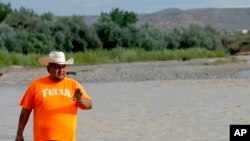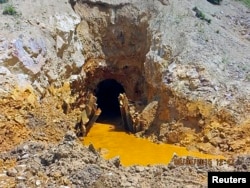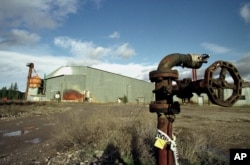Celebrities and politicians have rallied around the city of Flint, Michigan, where thousands of children have been exposed to unsafe levels of lead in drinking water. But Native Americans say they have been facing an even more dangerous water contaminant for decades - uranium - and received far less attention
The Cold War arms race triggered a boom in uranium mining in the U.S. Between the 1940s and 1980s, uranium mining operations were carried out under a 19th century mining law that did not require them to clean up after themselves.
When demand for uranium waned in the 1980s, companies simply walked away, leaving open pits and tunnels - and enormous amounts of radioactive waste. Today more than 15,000 abandoned uranium mines dot the U.S. West. Three-quarters of them are located on federal and tribal lands.
Ray Manygoats grew up near Tuba City, Arizona, near a now-abandoned uranium mine. He is no stranger to the substance the Diné (Navajo) people call “the yellow monster.”
“Yellow stuff was always everywhere,” Manygoats told the House Oversight Committee in 2007. “I saw liquids bubbling and tried to stay away from them…we would play in the yellowcake sand near the mill, jumping and rolling around in it.”
Manygoats has suffered from a variety of health troubles, including growths on his eyes; his father has respiratory problems.
Effects on drinking water
“There is a really large and convincing and definitive literature that shows that for miners working underground, uranium mining is associated with a greatly increased risk of lung cancer,” said Douglas Brugge, Professor of Public Health and Community Medicine at Tufts University School of Medicine. “We also know that uranium, radium, radon and arsenic – which is frequently in the ore as well – are toxic. And we know from a fairly large number of studies that people who are drinking water contaminated with uranium have some adverse health effects, mostly kidney damage.”
In 2014, University of New Mexico researchers sampled mine waste at one Arizona site and found uranium concentrations in spring water that was four times the federal drinking-water limit. Thirty percent of Diné lack access to public water and are forced to drink from unregulated wells, springs and livestock ponds, any of which could be contaminated.
Mining ongoing
Today, only a few companies continue to mine for uranium in the U.S. The most common method is in situ leaching: oxygenated water is injected into the earth, where it dissolves uranium. The solution is then brought back up to the surface and shipped off to processing plants.
In situ mining has been going on since 1988 in northwestern Nebraska, not far from the South Dakota Pine Ridge Reservation that is home to the Oglala Lakota people.
“We are 30 minutes away as the crow flies, fifteen minutes as the wind blows, from the mine site,” said Debra White Plume, executive director of Owe Aku (“Bring Back the Way”), a grassroots Lakota environmental group.
White Plume and other concerned activists have gone up against one of the world’s largest mining corporations in an attempt to block it from opening up three new mines in the area.
Ninety-eight wells have had to be closed on Pine Ridge because of unusually high rates of cancer, kidney disease and other health problems, said White Plume. She’s convinced that uranium is to blame, and she grows frustrated over suggestions that poor diet or smoking could be a factor.
“Why do the innocent human beings at home have to prove that the big corporation is contaminating them? Why aren’t laws in place that say, ‘OK, if that corporation is going to come into our community, let them show us how they will not harm us, let them show us how they aren’t going to threaten everything we depend on for life: Water, food, air, land?’” she asked.
The US Environmental Protection Agency says it has spent more than $100 million to identify areas at highest risk, part of a multi-year plan to address uranium contamination across the country.















